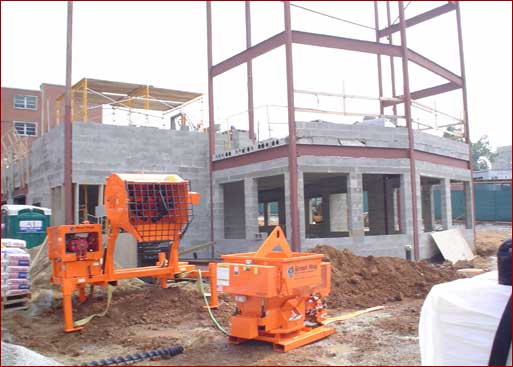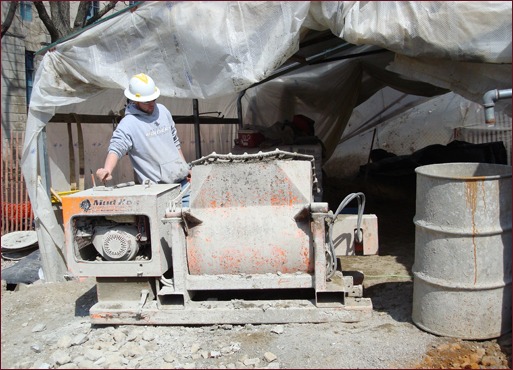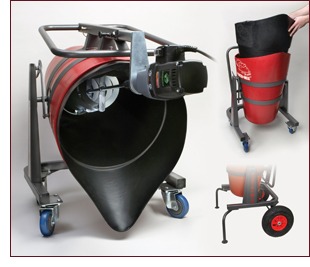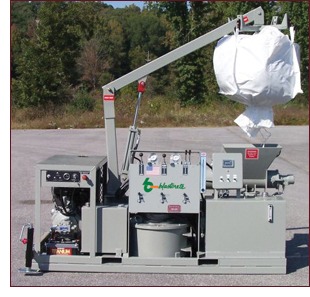Mixers, Pumps and Delivery Systems
Considerations When Purchasing a Mixer

Like cars, trucks, tractors and cranes, mixers are not what they used to be. Some are built on price, some on ergonomics, and some on quality. Mason contractors face the same issues day in and day out, including deciding on equipment to use on a job, whether to rent or buy, and when the right time is to make that investment. As contractors reach the time to replace or upgrade their fleets, the following comparisons should be considered.
Rent or own?
The golden rule on most equipment is that if you use it more than 75 percent of the time, it is cheaper to own than to rent. However, other factors, such as the availability of the equipment and how far the rental yard is from your shop, will play a role in this decision. This is especially true regarding smaller equipment, such as mortar mixers, for which you must pay delivery charges, or pay one of your own people to pick up and return to the rental yard for each use. Therefore, on smaller equipment, 50 percent usage may be a closer measure.
Buying price versus value
Mixers vary from reasonably priced – built out of light materials – to higher priced when built from heavy materials. If you are a contractor doing residential work or light weight commercial work, and only using a mixer for a few batches of mortar per day or a week, buying a low-priced, light-duty mixer probably is the way to go as these mixers can last a long time under those conditions. They also weigh less, which makes them easier to move around when no forklift or other equipment on the job is available to assist with the move.
On the other hand, if you are doing commercial work and have several people relying on many batches of mortar daily to keep your people busy, buying the cheaper line mixer will cost you much more in the long run. Studies show that only 30 percent of the cost of an industrial piece of equipment is incurred the day the equipment is purchased, while 70 percent of the cost is incurred during use, via maintenance, repairs and lost time, due to break downs. Especially in the current economic climate, the life cycle cost of the equipment can make a significant difference.
Concrete mixers versus mortar mixers
Until a few years ago, concrete could be mixed only in drum rotation mixers. These mixers are reasonably priced and work well for small volumes of concrete. However, some manufacturers build mortar mixers that can mix concrete as well as mortar. These higher production mixers cut through the material during the mixing process, instead of tumbling it like the traditional concrete mixers do. This also gives the contractor the option of mixing mortar or concrete in the same mixer, so he doesn’t have to have two different types of mixer on site, when one will do the job for both mortar and concrete.
Large or small?
The rule or maximum productivity: the larger the project, the larger the mixer. Small mixers are fine for small projects, for which only one or two bricklayers are working on site. On larger projects that require several bricklayers, larger mixers are required to keep up with the mortar demand as bricks, blocks or stone can be laid only when mortar is on the masons’ boards. If masons are standing around waiting for the mortar man to mix batch after batch from the same mixer, when he could be mixing several batches at once in one mixer, the job is losing money. One also must consider that more than 50 percent of the mortar is mixed in only two hours of the day: the first hour in the morning and the first hour after lunch. Larger mixers are required on larger jobs to supply this mortar during these heavy usage periods, or production will suffer.
Electric or gas?
Most contractors prefer gas to electric mixers. Gas allows you to put the mixer anywhere on the jobsite, without running an electric power source to it. Later, if you need place it on the other end of the jobsite, you can do so easily. It also takes 220 amps to power most mixers, which is difficult access on most jobsites. This prevents electric from being a viable option. However, some advantages of going electric do exist. If you have an inside job, no exhaust fumes are present when using an electric mixer. Also, you can save several gallons of gas per day by using an electric power source.
Belts, gear boxes versus hydraulic
Cheaper line mixers come with v-belts or gear boxes. These mixers work fine, as long as the person mixing is adds enough water during the mixing process not to plug the mixer. If he does plug it, production stops, while he shuts down the mixer and digs out the dry material. This, alone, can cost a contractor a lot of money during a plug. The belts also may burn up, or pins can shear during a plug, leading to longer job delays as the mixers are being repaired. On the other hand, most hydraulic mixers are reversible, so the laborer simply can reverse the paddle rotation, and the mixer unplugs itself automatically. Even the highest quality mixers have a cross port hydraulic relief valve built into the system, which allows hydraulic fluid to run over the relief during a plug, avoiding any damage to the mixer during a plug. Of course, for this convenience, these mixers come with a higher price tag.
Electric versus a pull-cord start
Mason contractors know that every time you pull on the cord of mixer to start it, you are one pull closer to breaking the cord. Investing in a mixer that has an electric start negates the need to carry extra rewind coils in your trucks, in the event your cord snaps in half. In fact, the only reason you ever need to pull-start an electric start mixer is if someone leaves the key on, and the battery dies. With the seldom need to pull-start these mixers, the coils can last years without being replaced or repaired.

Standard versus reinforced rubber blades
Like other mixer components, the mixer manufacturer saves money by installing standard rubber blades on the mixers they produce. However, regular rubber will not stand up to the daily abuse of mixing materials and, therefore, become worn out or torn during the first few weeks of operation. As soon as this happens, the laborer who is mixing pays the price through extra time spent cleaning the mortar or concrete build up from the sides and ends of the drum. This all costs time and money daily, so it is recommended that you check to see what kind of a warranty the mixer manufacturer has on the rubber blades of the mixers you’re buying. If no warranty exists, you know a high-quality, reinforced rubber has not been used.
Low or high load?
Traditional mixers were built to load high and dump low, as mixers can be built more economically that way. Today, some mixer manufacturers have ergonomically designed mixers that can be loaded below waist high, yet can be dumped into a high wheel barrow. These mixers save strain on the laborers’ backs, by using cylinders to lift the weight of the material after the mixer is loaded, rather than the laborer lifting the material up above his chest during the loading process.
Enclosed versus exposed bearings
Traditionally, mixers were built with bearings against the drums, at the pivot point of the shaft. These mixers work fine, until seals or a bearing goes bad and a mechanic has to spend a half-day removing the drum on the mixer to replace seals or bearings. Mixer companies are building mixers with the bearing points away from the pivot points, so bearings and seals can be replaced in minutes instead of hours. Some mixers are designed with the bearings and seals separated from one another, so when the seals leak, they do not leak directly into the bearings. This avoids damaging the bearings and the shaft, should the seals begin to leak.
Loading by shovel versus silo or skid steer
On high-production jobs, loading mixers by hand is slowly becoming a thing of the past. Therefore, most commercial contractors use silos to load their mixers. Other contractors are using skid steer loaders and loading with measuring buckets that dump sand directly into mixers. Both methods save a ton of labor versus loading by the traditional shovel-loading method.
Finding your mixer
Each mixer has its place in the market, serving a specific need. When looking for your next mixer, consider the price tag; answer the rent-versus-own question as it pertains to your financial situation; and then go one step further – consider the life cycle costs of the models you are comparing, along with the sizes and types of jobs you do. Once you have carefully calculated and weighed the risks and options, you can confidently make the best possible call for your personal circumstance.
| Product Spotlight |
 New from CS Unitec is the HIPPO PMH 70F-RL portable mixing station, which allows multiple batches of construction compounds to be mixed easier and faster, using a removable liner and rimless bucket system. Consecutive batches can be mixed without downtime for cleaning the bucket. Alternating liners allow mixing without cross contamination. The resilient, pliable liner is removed and cleaned easily. It also extends the bucket life. New from CS Unitec is the HIPPO PMH 70F-RL portable mixing station, which allows multiple batches of construction compounds to be mixed easier and faster, using a removable liner and rimless bucket system. Consecutive batches can be mixed without downtime for cleaning the bucket. Alternating liners allow mixing without cross contamination. The resilient, pliable liner is removed and cleaned easily. It also extends the bucket life.
The PMH 70F-RL features an Easy-roll Trolley and balanced Easy-tilt Cradle, allowing one person to mix, transport and accurately place up to 20 gallons of material at the same time. Equipped with heavy-duty casters, the PMH 70F-RL moves freely on level floors. Wheel covers ensure that the casters remain free of screed splatter. The HIPPO also can be equipped with air-filled tires for construction sites with rough, uneven terrain. The HIPPO is ideal for mixing cement screeds, grout, mortar, texture coatings, sealants, adhesives and other self-leveling compounds and construction materials. It is supplied with two mixing paddles designed with a special helix ribbon and side bars. It has a 16-amp/1800-watt, two-speed motor. CS Unitec offers an optional pneumatic-powered motor for the PORTAMIX HIPPO as well. Learn more at www.csunitec.com. |
| Product Watch |
 Blastcrete Equipment Co.’s Mason Mate was designed primarily for high-rise block fill applications, as well as concrete repair and underground shotcrete for mining and tunneling applications. The unit features Blastcrete’s D3522 hydraulic squeeze pump, a high-shear continuous mixer and an optional, 1,000-pound capacity bag lifter. Designed to increase material delivery time, the Mason Mate provides a significant time- and labor-saving solution on the jobsite. Blastcrete Equipment Co.’s Mason Mate was designed primarily for high-rise block fill applications, as well as concrete repair and underground shotcrete for mining and tunneling applications. The unit features Blastcrete’s D3522 hydraulic squeeze pump, a high-shear continuous mixer and an optional, 1,000-pound capacity bag lifter. Designed to increase material delivery time, the Mason Mate provides a significant time- and labor-saving solution on the jobsite.
Mason Mate is designed to be a fast, efficient, one-man solution. Rather than mixing material and water offsite, then transporting the blended material with telehandlers to be installed, the Mason Mate is able to perform the entire process from start to finish, right on the jobsite, and requires just one operator. The unit saves valuable time by being operated onsite and in close proximity to the mason, while also eliminating the need for several pieces of large, equipment, wheelbarrows and “bucket brigades” consisting of multiple laborers. Featuring a compact design, the Mason Mate easily fits in the back of a pickup truck or in a freight elevator, and can operate within an eight-foot ceiling. Furthermore, the compact design allows easy maneuverability with a pallet jack and placement with a telescoping forklift or crane. Mason Mate includes a two-inch, hydraulic squeeze pump with variable speed up to six cubic yards per hour, and a high-shear continuous mixer for increased speed and shorter mixing time. The unit is capable of pumping 3/8-inch aggregate mixes at 450 psi pumping pressure. To relieve pressure build-up clogs and eliminate potential damage to the pump, the Mason Mate’s D3522 can be run in both forward and reverse. Hydraulic controls for the pump, mixer and re-mixer are located on the operator’s control dash. Mason Mate’s primary wear part, the rubber pumping tube, can be replaced easily on the jobsite in about 20 minutes. Clean-up on the squeeze pump is fast and hassle free, using just water and a sponge ball and taking only five minutes. A 29-hp Kubota water-cooled diesel is standard. The Mason Mate also is available with either a 35-hp Briggs & Stratton gasoline engine or 30-horsepower electric motor with starter and disconnect. Learn more at www.blastcrete.com. |